Last Updated on April 20, 2024 by Kittredge Cherry
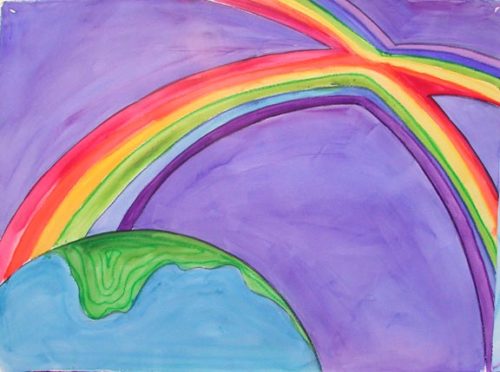
On Earth Day queer spirituality affirms that God’s all-inclusive love extends to the Earth itself. Many LGBTQ people join with others to care for creation on Earth Day (April 22). LGBTQ people have been involved in the environmental movement from the start, including Rachel Carson, marine biologist and bestselling author. Care for creation is celebrated at Q Spirit in queer green theology, art, books, and prayer on Earth Day.
Earth Day is especially significant for LGBTQ people because they are disproportionately harmed by climate change, and nature provides affirmation for queer identities. Queerness exists throughout the natural world, including fish that change gender, same-sex behavior in birds and animals, fungi with thousands of genders and intersex flowers. Diversity of genders and sexual orientations is embedded in the web of life. Unfortunately human societies have marginalized LGBTQ people, with family conflicts putting them at greater risk of homelessness and making them more vulnerable to climate change and pollution with limited access to resources.
The Earth gives rise to rainbows and the full spectrum of sexualities and gender diversities across countless species over time. If “queer” means love beyond ordinary boundaries, then it fits our oddly lively, colorful planet spinning and circling in the otherwise lifeless solar system. At least one LGBTQ-affirming congregation added the Earth itself as a member.
Earth Day prayer
Rosa Bonheur, a 19th-century painter who broke gender rules, had a queer faith that included rewriting traditional prayers. Her version of the “Hail Mary” is appropriate for Earth Day:
Hail, O earth full of grace,
the living God is with you.
Blessed are you among all the planets,
the fruit of your womb is our salvation.
Holy earth, mother of love,
pour out your grace on those who suffer,
now and in our divine transformation.
Rainbow Christ meets Tree of Life
Nature and Christianity come together in the Tree of Life cross, one of the earliest symbols in Christian art. Every Tree of Life cross is filled with leafy vegetation. Sometimes the face of Jesus is in the center. Other versions simply show a vine — or a tree with trunk growing upward from the base and branches stretching out along the arms of the cross. The image symbolizes the connection between heaven and earth.
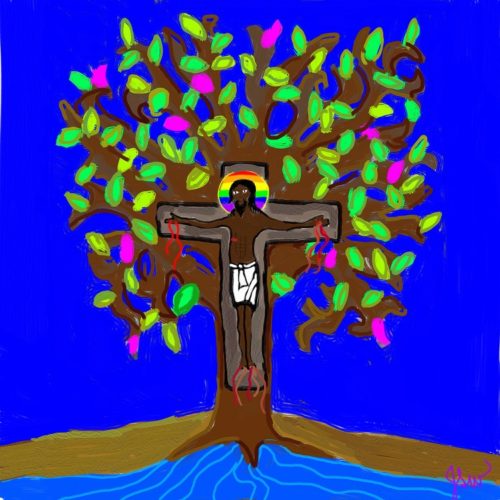
“Jesus, Christ-Sophia the Liberator, Tree of Life” by Jeremy Whitner.
Care for the earth unites with LGBTQ spirituality in a 2022 painting of Jesus with a rainbow halo crucified on a Tree of Life. “Jesus, Christ-Sophia the Liberator, Tree of Life” was painted by North Carolina artist Jeremy Whitner. He is a queer Christian iconographer in process for ministry with the Disciples of Christ while attending Union Presbyterian Seminary in Charlotte. Prints and other items with his artwork are available through his shops at Fine Art America and Pixels.
It is part of his series on “Rainbow Christ-Sophia.” The name evokes Christ’s solidarity with women and the LGBTQ community, whose symbol is the rainbow flag. Sophia is Greek for “wisdom” and represents the female incarnation of Wisdom in the Bible (Proverbs 8:22-31). Sophia has been interpreted as a Christ figure since the early church, and she has appeared in Byzantine churches and icons at least since the Middle Ages. The dark skin of this Jesus speaks for itself to express Christ’s solidarity with people of color. The rainbow Christ-Sophia stands for and suffers with people who are oppressed for any reason, including LGBTQ people. Whitner was inspired to by the Rainbow Christ Prayer when he began painting his Rainbow Christ-Sophia series in 2022. The series includes scenes from Christ’s Passion and resurrection.

“Tree of Life” by Robert Lentz is available from Amazon and Trinity Stores.
A Tree of Life icon was created by Robert Lentz, a Franciscan friar known for his innovative and LGBT-positive icons. He is stationed at Holy Name College in Silver Spring, Maryland. The icon’s official narrative at TrinityStores.com explains what the image says about Christ’s relationship with the earth:
He is the fulfillment of the ancient Green Man of old Europe, as well as the vine spoken of in John’s Gospel. He is the World Tree, Yggdrasil, the pole of the universe, upon which shamans and other mystics travel to experience the divine. Having become part of creation, and unjustly executed, he is the advocate of all those who have been trampled underfoot. Slain on the cross, but risen, he declares that God’s greatest miracle is to bring life and light even out of injustice and death.
Rainbow Christ as creator of nature
A queer, dark-skinned Christ is envisioned as creator of all nature by artist Jeremy Whitner in his 2023 image “The Face of G*d, the Rainbow Christ-Sophia at Creation.”
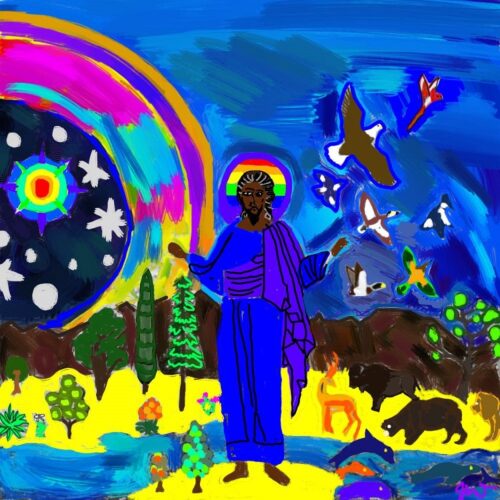
“The Face of G*d, the Rainbow Christ-Sophia at Creation” by Jeremy Whitner.
It is based on traditional iconography of creation, but Whitner uses a radiant rainbow sun and colors of the trans flag to light up the night sky, celebrating the diversity of the natural world. The Rainbow Christ-Sophia lives in a landscape teeming with life, surrounded by an array of birds, animals, fish and trees. For more images from Whitner’s Rainbow Christ-Sophia series, see the Q Spirit article “Black Jesus, Latinx Jesus, female Christ and other liberating visions join the gay Passion of Christ.”
LGBTQ people speak for the earth: Rachel Carson
LGBTQ people have been involved in the environmental movement from the start, including one of its best-known leaders: marine biologist Rachel Carson (1907-1964). Her groundbreaking 1962 book “Silent Spring” revealed how pesticides harm natural habitats and humankind, sparking the global ecology movement and leading to the formation of the U.S. Environmental Protection Agency.
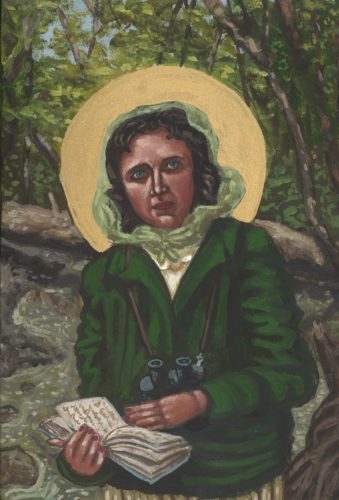
Rachel Carson by Kelly Latimore
Carson, who never married, is assumed to be a lesbian because of her 12-year romantic relationship with her neighbor, Dorothy Freeman. They destroyed many of their letters to each other before they died, perhaps to hide the full truth of their relationship, but their surviving love letters are published in the book, “Always, Rachel.” Raised Presbyterian, Carson did not attend church as an adult but affirmed spirituality through nature. In a 1954 speech to a women journalists, she said:
“I am not afraid of being thought a sentimentalist when I stand here tonight and tell you that I believe natural beauty has a necessary place in the spiritual development of any individual or any society. I believe that whenever we destroy beauty, or whenever we substitute something man-made and artificial for a natural feature of the earth, we have retarded some part of man’s spiritual growth.”
Carson receives a saintly halo in an icon by Kelly Latimore. Dressed in dark green, she appears to emerge from a forest with her book and binoculars. Latimore also created an icon of Mary Oliver, a lesbian who celebrates nature through poetry. Latimore is known for painting innovative icons of unlikely contemporary saints such as Stonewall saint and trans activist Marsha P. Johnson. He began painting icons in 2011 while he was a member of the Common Friars, an Episcopal monastic community in Ohio.
Queer Cosmic Christ is incarnated in creation
A Cosmic Christ appears with subtle LGBTQ symbolism in the work of Chicago artist Doyle Chappell. The phrase “Cosmic Christ” refers to Christ who is continually incarnated in all creation.
Chappell has done variations on the Cosmic Christ theme for years, including in the colorful windows dedicated in 2015 at the LGBTQ-affirming A Church 4 Me Metropolitan Community Church.
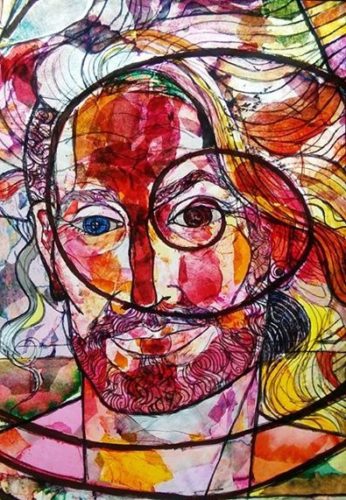
“Cosmic Christ” by Doyle Chappell
“In the windows for A Church 4 Me in Chicago, the Christ wears a diamond earring on the left ear which for me is a bit of a gay reference,” Chappell told the Jesus in Love / Q Spirit blog.
Multiple intersecting and nested pink triangles within triangles repeat a symbol imposed on gay prisoners in Nazi Germany and later reclaimed by the LGBTQ community.
“The triangle is more than a gay symbol,” Chappell explained. “It is to me a symbol of ancient wisdom that points to a higher level of consciousness toward the ‘Omega Point’ as expressed by the philosopher and Jesuit priest Pierre Teilhard de Chardin, one of the first theologians to show interest in the ‘Cosmic Christ.’”
 Chappell’s art is also inspired by the book “The Coming of the Cosmic Christ: The Healing of Mother Earth and the Birth of a Global Renaissance” by Matthew Fox, a Dominican friar who became an Episcopal priest and helped launch the Creation Spirituality movement.
Chappell’s art is also inspired by the book “The Coming of the Cosmic Christ: The Healing of Mother Earth and the Birth of a Global Renaissance” by Matthew Fox, a Dominican friar who became an Episcopal priest and helped launch the Creation Spirituality movement.
Ultimately Chappell used LGBTQ imagery to enhance his vision of a Cosmic Christ for everybody. “My main intent was to honor the idea that ‘The Cosmic Christ’ is in all that has been created since the Big Bang and beyond our concepts of Christianity…in all particles of creation and certainly all life and honors all who seek to connect with the sacred wisdom,” he said.
He reiterated the concept of an all-inclusive Christ by making one eye blue and the other brown. “The hair of many colors explodes beyond the box and not only expresses absolute diversity but also the fire of the Holy Spirit,” Chappell added.
The 15-by-15-foot Cosmic Christ windows at A Church 4 Me were constructed with watercolor paper on clear acetate and painted with acrylic glazes. The technique results in a spectacular stained-glass effect.
The Chicago windows are the latest of several Cosmic Christ artworks that Chappell created for MCC, a denomination ministers primarily in the LGBTQ community.
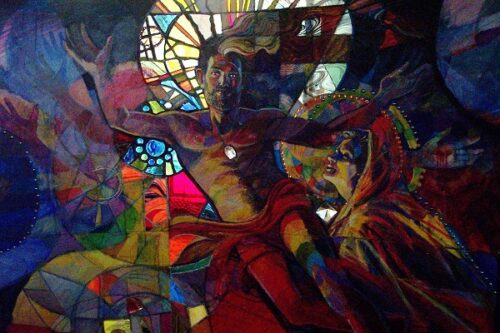
“Cosmic Christ” mural by Doyle Chappell, MCC of the Rockies, Denver, Colorado
At MCC of the Rockies in Denver he did a 20-foot-tall Cosmic Christ with the reflection of a rainbow on his left leg. The monumental mural is located directly behind the church’s altar. “I used LGBT male, female and straight models to build a composite image that crosses over all sexualities,” Chappell said.
He also painted the Cosmic Christ as a live performance before a crowd at an MCC conference in Chicago. That painting now belongs to MCC founder Troy Perry.
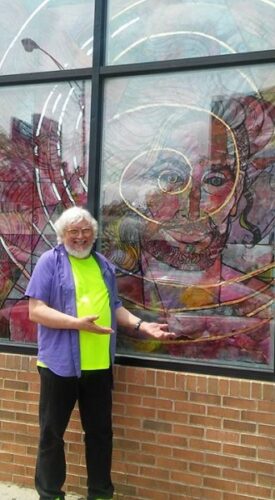
Artist Doyle Chappell stands outside his “Cosmic Christ” window in Chicago
While the Cosmic Christ is one of his favorite subjects, Chappell is best known for his portraits. From the beginning of his art studies at the University of Texas, Chappell liked painting people. He uses layers of bright colors and painterly brushwork to express the inner qualities and outward appearance of each individual. Serious art collectors value his work and his portraits are included in many private collections. Some of his favorite portraits are of “just plain folks,” but his well known subjects include actress Daryl Hannah and Lynda Johnson Robb, daughter of President Lyndon Johnson.
Queer green theology
LGBTQ Christians are transforming the larger church with a message of inclusion and embodiment, showing that God’s boundless love goes beyond traditional categories to welcome every sexual orientation and gender expression. Pioneering LGBTQ green theologians are taking the next step to extend the church’s welcome to the earth itself.
“My passion for the Earth came with the recognition of queer Christian inclusion and the radical inclusive mission of Jesus,” says Robert Shore-Goss, a theologian and pastor who brings together queer and green spiritualities. He is the author of LGBTQ classics such as “Queering Christ” and “Jesus Acted Up.”
 The renowned queer theologian expands his vision to the whole environment in his 2016 book “God Is Green: An Eco-spirituality of Incarnate Compassion.” The author presents the risen Christ as Gardener who liberates people from restrictive spiritualities that exclude and damage the earth. The book aims to foster ecological conversation and action in churches. Evangelical environmentalists tend to use the term “creation care” for this movement.
The renowned queer theologian expands his vision to the whole environment in his 2016 book “God Is Green: An Eco-spirituality of Incarnate Compassion.” The author presents the risen Christ as Gardener who liberates people from restrictive spiritualities that exclude and damage the earth. The book aims to foster ecological conversation and action in churches. Evangelical environmentalists tend to use the term “creation care” for this movement.
Building on the ideas of creation spirituality pioneer Matthew Fox in “Original Blessing,” Shore-Goss redefines Original Sin, “greens” Biblical hermeneutics and retrieves the mystic medieval spiritualities of queer saints such as Francis of Assisi and Hildegard of Bingen. Francis preached to birds and celebrated “Brother Sun” and “Sister Moon.” And celebrated “Brother Sun” and “Sister Moon.” Hildegard wrote frequently about “viriditas,” the divine greening force of nature expressed in a word that combines Latin for “green” and “truth.”
 He also wrote a comprehensive chapter called “Grace is Green: Incarnational Inclusivities” in the 2013 book that he co-edited, “Queering Christianity: Finding a Place at the Table for LGBTQI Christians.”
He also wrote a comprehensive chapter called “Grace is Green: Incarnational Inclusivities” in the 2013 book that he co-edited, “Queering Christianity: Finding a Place at the Table for LGBTQI Christians.”
“Christian blood atonement theologies have historically been violent, if not bloodthirsty — scapegoating Jews, women, Muslims, indigenous peoples, non-Christian religions, and LGBT folks,” he writes in the chapter. By contrast, he says, “The green cross includes all life everywhere.”
Shore-Goss put queer green theology into practice as pastor of Metropolitan Community Church / United Church of Christ in the Valley in North Hollywood, California, from 2004 to 2017. His mostly LGBTQ congregation installed solar panels, jack-hammered an asphalt area to make a garden on their property, and found many ways to cut their church’s use of energy and water. As described on his website mischievousspiritandtheology.com, water conservation became a spiritual discipline for Lent and gardening was an Easter practice.
The MCC in the Valley website expands the common understanding of John 3:16: “For God so loved the world as to give the only begotten Child that whoever believes may not die but have eternal life.” The site points out, “The world includes more than humanity, but all life, our planet, and universe. All life is sacred, indeed.”
“We understood the Earth as a living being, producing and evolving diverse life forms,” he wrote in his chapter. “We made the Earth a member of the church on one Earth Day Sunday to symbolize the great commandment that loving God and loving our neighbor included loving the Earth and taking responsibility for diversity of life.”
Books on ecology and Christianity from an LGBTQ viewpoint
Green spirituality has been explored by many people, from ecofeminists to radical faeries, but Shore-Goss is among only a handful of theologians who have written about the connections between ecology and Christianity from a LGBTQ perspective. Others include:
 “Meaningful Flesh: Reflections on Religion and Nature for a Queer Planet” by Whitney Bauman (editor). Both religion and nature are surprisingly queer, according to contributors to this 2017 collection of scholarly essays. They challenge boundaries by looking at African American religious naturalism, an irreverent theology of animal sexual behavior, a queerly theological anthropology of enchanting animals, queer ethics in the age of globalization and climate change, moving past violent binaries with “queer green sex toys,” and more. The editor is associate professor of religion at Florida International University in Miami. Other contributors are Jacob J. Erickson, Jay Emerson Johnson, Timothy Morton, “Gay and Gaia” author Daniel Spencer, and Carol Wayne White. Published by Punctum Books.
“Meaningful Flesh: Reflections on Religion and Nature for a Queer Planet” by Whitney Bauman (editor). Both religion and nature are surprisingly queer, according to contributors to this 2017 collection of scholarly essays. They challenge boundaries by looking at African American religious naturalism, an irreverent theology of animal sexual behavior, a queerly theological anthropology of enchanting animals, queer ethics in the age of globalization and climate change, moving past violent binaries with “queer green sex toys,” and more. The editor is associate professor of religion at Florida International University in Miami. Other contributors are Jacob J. Erickson, Jay Emerson Johnson, Timothy Morton, “Gay and Gaia” author Daniel Spencer, and Carol Wayne White. Published by Punctum Books.
* Daniel T. Spencer, who teaches environmental studies at the University of Montana, weaves together gay and ecological perspectives to build a solid Christian ethic in his 1996 classic book “Gay and Gaia: Ethics, Ecology, and the Erotic.”
* Greta Gaard was the first to bring together ecofeminism and queer theory with her influential 1997 article “Toward a Queer Ecofeminism.” It is included in the anthology “Perspectives on Environmental Justice, Gender, Sexuality, and Activism.” She is professor of English at the University of Wisconsin in River Falls.
* Kathy Rudy, lesbian feminist activist and associate professor of ethics and women’s studies at Duke University, applies her experience of the LGBTQ liberation movement to animal rights in her 2013 book “Loving Animals: Toward a New Animal Advocacy.”
* John Michael Clark, who taught English and religious studies at various colleges in Atlanta, shows the contribution that the LGBTQ liberation movement makes in an eclectic ecological vision with his 1993 book “Beyond Our Ghettos: Gay Theology in Ecological Perspective.”
Animal blessing ceremony
 One way that many LGBTQ people engage with the natural world is through their animals companions. Kittredge Cherry, a lesbian author ordained by MCC, wrote an animal blessing in the book she co-edited, “Equal Rites: Lesbian and Gay Worship, Ceremonies and Celebrations.” Here is an excerpt:
One way that many LGBTQ people engage with the natural world is through their animals companions. Kittredge Cherry, a lesbian author ordained by MCC, wrote an animal blessing in the book she co-edited, “Equal Rites: Lesbian and Gay Worship, Ceremonies and Celebrations.” Here is an excerpt:
Cats and dogs often become surrogate children for same-sex couples…. The discrimination faced by lesbian and gay people is linked to attitudes that devalue animals and the rest of nature. Western thought sets up dualities in which spirit is better than body, male is better than female, human is better than animal, intellectual is better than sexual — and sexuality defines gays and lesbians in this way of thinking. Gays and lesbians, like nature itself, are seen as something that must be controlled. The result is a sterile, exclusive church and a polluted earth. Many lesbians and gay men seek to remedy this situation by healing the spirit-body split in Christianity. For all these reasons, it is appropriate to bless animals in the context of lesbian and gay spirituality….
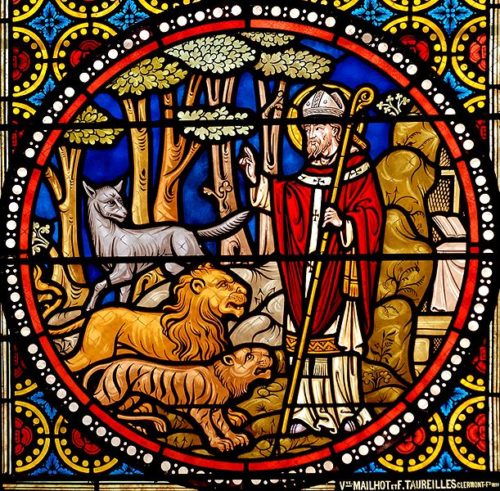
“Saint Austremonius with the beast of the wild” (Wikimedia Commons)
May we remember that humanity is but one small, fragile strand in the interdependent web of life.
May we remember that we human beings are not the only ones created to look at flowers, to taste cool water, to listen to the wind, and to feel the earth beneath our feet.
May we remember that what befalls the earth befalls all who live on her lovely shores.
May we never forget that to harm the Earth is to scorn the Creator.
We pray for the animals who are our companions.
We pray for the wildlife displaced as we develop land for human use.
We pray for the animals who work for us, including the seeing-eye dog, the carriage horse, and the laboratory rat.
We pray for animals who are bought and sold, animals who live in cages, and animals who live free.
We pray for animals indigenous to this particular place, including [name a few species].
We pray for the animals who have made our lives possible by becoming food and clothing for us.
We pray for endangered species, including the giant panda and the California condor, and we remember the dinosaurs, passenger pigeons, and other extinct species.
We pray for all human beings who have felt degraded by being compared to animals.
God, we know that you hear all or prayers, those spoken and those that we hold silently in our hearts. We claim your loving presence with us now.
“Miss American Green Cross”
Cherry appears in a photo with a monument honoring the early environmental movement. A female Christ figure stands in front of a green cross with arms outstretched over a pile of tree stumps and sawed-off logs. Her plea is stated on the pedestal: “Help save our trees.”
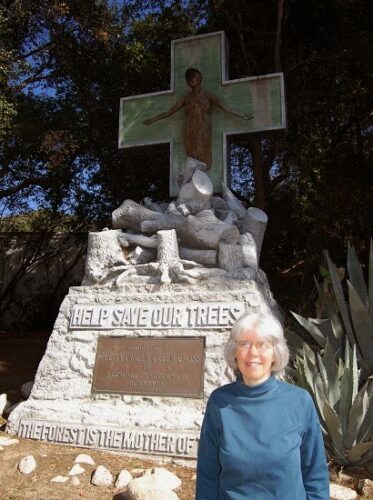
Kittredge Cherry visits a green-cross sculpture honoring the early environmental movement
“Miss American Green Cross” was sculpted in 1928 by artist Frederick Willard Potter for the Green Cross Society, an ecology group based in Glendale, California. According to press reports, “It is the first of dozens of statues to be erected all over America as part of the doctrine of saving the nation’s forests.” The organization disbanded in the 1930s, but the statue and its strikingly contemporary message remain.
Some have mistaken the mysterious Miss American Green Cross for Joan of Arc about to be burned at the stake. But this goddess-like bronze figure appears to be a female Christ, embodiment of Holy Wisdom (Sophia). She seems to express the theology of the green cross described by Shore-Goss and others, drawing parallels between the destruction of forests and the crucifixion of Jesus. The sculpture is located at the Brand Library in Glendale. The photographer was Audrey Lockwood.
Links about the queerness of nature
Nature is queer—and we should embrace that! (wilderness.org)
Queer Ecology: 8 Examples in Wildlife (thecommons.earth)
___
Top image credit:
Double rainbows cross over the earth in “High and Lifted Up” by Gwen Meharg
This article was originally published on Q Spirit in April 2017, was expanded with new material over time, and was most recently updated on April 20, 2024.
____
This post is part of the LGBTQ Calendar series by Kittredge Cherry. The series celebrates religious and spiritual holidays, events in LGBTQ history, holy days, feast days, festivals, anniversaries, liturgical seasons and other occasions of special interest to lesbian, gay, bisexual, transgender and queer people of faith and our allies.
Copyright © Kittredge Cherry. All rights reserved.
Qspirit.net presents the Jesus in Love Blog on LGBTQ spirituality.






